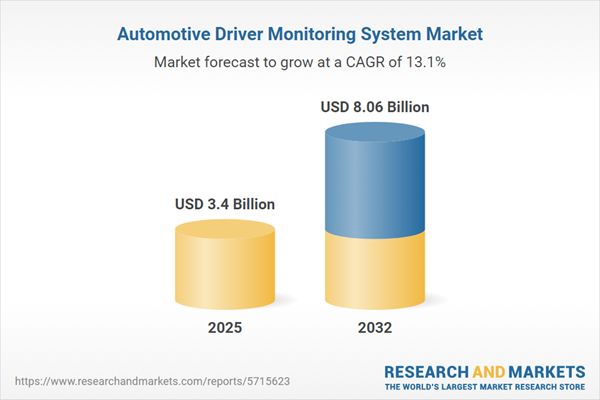Speak directly to the analyst to clarify any post sales queries you may have.
Senior automotive leaders are navigating a transformative phase in the automotive driver monitoring system market, as regulatory frameworks tighten and advanced in-cabin safety expectations evolve. Success now relies on forward-thinking strategy, adaptive technology deployment, and risk mitigation that ensures both compliance and competitive differentiation in a rapidly shifting sector.
Market Snapshot: Automotive Driver Monitoring System Market
The global automotive driver monitoring system market reached a valuation of USD 3.01 billion in 2024, with forecasts projecting growth to USD 3.40 billion in 2025 and a further rise to USD 8.06 billion by 2032. Driving this market is a compound annual growth rate of 13.09%, supported by escalating safety mandates and new compliance benchmarks worldwide. Leading industry players leverage innovations in multi-modal sensing, increasingly advanced analytics, and refined regulatory frameworks to strengthen both market position and value creation strategies. As these solutions mature, automotive manufacturers adopt data-driven leadership to define operational excellence in a compliance-centric environment.
Scope & Segmentation of the Automotive Driver Monitoring System Market
- Technology: Includes camera-based monitoring using monocular and stereo vision, EEG-based physiological monitoring for in-depth alertness assessment, infrared sensing tailored for low-light situations, and radar approaches such as millimeter-wave and short-range types, supporting adaptability across various vehicle environments.
- Components: Encompasses sensor arrays for continuous driver assessment, sophisticated processors for real-time analytics, middleware to enable systems integration, deep learning software capable of advanced behavioral pattern recognition, and application modules designed for scalable deployment.
- End User: Addresses integration of these systems within original equipment manufacturer (OEM) vehicle platforms, as well as retrofit options for legacy fleets and private vehicles, extending the reach of compliance upgrades across broad market segments.
- Application: Focuses on monitoring for fatigue, driver distraction, emotional and cognitive states, as well as employing facial and voice recognition to raise compliance levels and enhance occupant safety and in-cabin experience.
- Vehicle Type: Solutions are compatible with battery electric, fuel cell, hybrid, and a range of commercial vehicle classes, supporting industry trends toward electrification and diversification in fleet configurations.
- Region: Market analysis spans the Americas, Europe, Middle East, Africa, and Asia-Pacific, with a specific emphasis on regulatory changes and adoption rates in countries such as China, India, Japan, and Southeast Asian nations.
- Leading Companies: Profiles include Continental Aktiengesellschaft, Valeo SA, Robert Bosch GmbH, Denso Corporation, Aptiv PLC, Magna International Inc., Visteon Corporation, Seeing Machines Limited, Smart Eye AB, and Panasonic Corporation, covering product development, partnership approaches, and positioning within the competitive landscape.
Key Takeaways for Strategic Leadership
- Advanced monitoring systems solidify compliance processes and build trust among regulatory bodies and stakeholders, positioning organizations strongly amidst evolving global standards.
- Investment in artificial intelligence and smart sensor development enhances detection capabilities, enabling more proactive fleet management and improved in-cabin safety outcomes.
- Flexible integration of radar, EEG, and infrared sensing technology allows providers to scale products across diverse regulatory regions, aligning with multinational expansion plans.
- Availability of OEM and aftermarket driver monitoring solutions enables organizations of all sizes to accelerate deployment and stay competitive in rapidly changing markets.
- Collaboration among automotive manufacturers, components suppliers, and technology innovators anchors compliance, accelerates innovation cycles, and streamlines regulatory response efforts.
- Integrated analytics and multi-modal sensing redefine the in-cabin experience, with safety and occupant comfort now driving purchasing decisions in both established and emerging markets.
Tariff Impact and Supply Chain Adaptation
Forthcoming U.S. tariffs set for 2025 are compelling market leaders to strengthen supply chain resilience. This includes diversifying supplier networks, scaling up domestic production, and elevating research and development investments. Such adaptation minimizes disruption and preserves business continuity as industry supply chains respond to ongoing global trade adjustments.
Methodology & Data Sources
This report utilizes executive interviews from leading OEMs, tier-one suppliers, and regulatory advisors, integrated with high-quality industry publications, patent reviews, and scenario modeling. This multi-faceted approach ensures that findings are both robust and relevant for leaders steering adoption and compliance initiatives in automotive driver monitoring systems.
Why This Report Matters
- Supports executive decision-making by pinpointing regulatory and safety trends that guide future technology investments in the automotive driver monitoring system market.
- Delivers region-specific intelligence and supply chain perspectives to help organizations mitigate risks and secure sustainable growth trajectories.
- Equips leadership teams with actionable insights to maximize resource allocation, strengthen market position, and adapt to rapid industry shifts.
Conclusion
The findings presented here provide automotive executives with practical guidance for risk management, technology acceleration, and strategic development. Applying these insights supports confident decision-making and sustained organizational success amid regulatory and technological complexity.
Additional Product Information:
- Purchase of this report includes 1 year online access with quarterly updates.
- This report can be updated on request. Please contact our Customer Experience team using the Ask a Question widget on our website.
Table of Contents
3. Executive Summary
4. Market Overview
7. Cumulative Impact of Artificial Intelligence 2025
Companies Mentioned
The companies profiled in this Automotive Driver Monitoring System market report include:- Continental Aktiengesellschaft
- Valeo SA
- Robert Bosch GmbH
- Denso Corporation
- Aptiv PLC
- Magna International Inc.
- Visteon Corporation
- Seeing Machines Limited
- Smart Eye AB
- Panasonic Corporation
Table Information
| Report Attribute | Details |
|---|---|
| No. of Pages | 188 |
| Published | November 2025 |
| Forecast Period | 2025 - 2032 |
| Estimated Market Value ( USD | $ 3.4 Billion |
| Forecasted Market Value ( USD | $ 8.06 Billion |
| Compound Annual Growth Rate | 13.0% |
| Regions Covered | Global |
| No. of Companies Mentioned | 11 |









